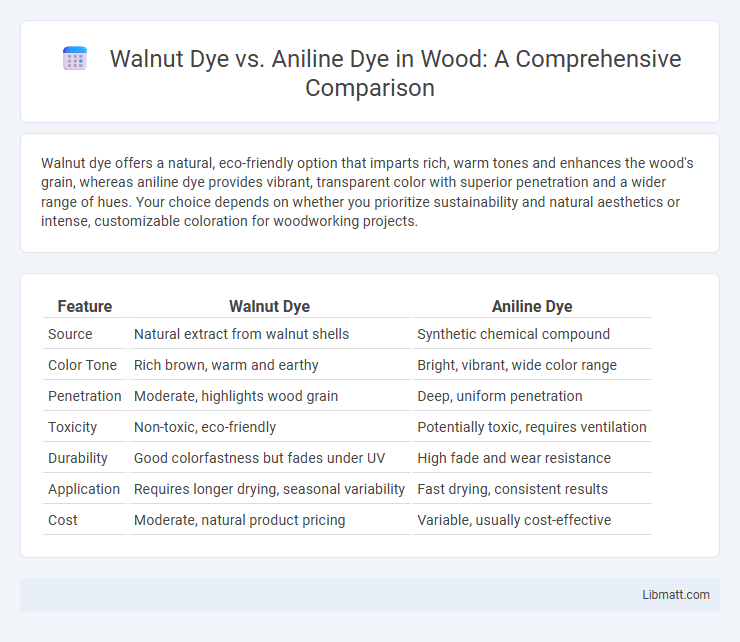Walnut dye offers a natural, eco-friendly option that imparts rich, warm tones and enhances the wood's grain, whereas aniline dye provides vibrant, transparent color with superior penetration and a wider range of hues. Your choice depends on whether you prioritize sustainability and natural aesthetics or intense, customizable coloration for woodworking projects.
Table of Comparison
| Feature | Walnut Dye | Aniline Dye |
|---|---|---|
| Source | Natural extract from walnut shells | Synthetic chemical compound |
| Color Tone | Rich brown, warm and earthy | Bright, vibrant, wide color range |
| Penetration | Moderate, highlights wood grain | Deep, uniform penetration |
| Toxicity | Non-toxic, eco-friendly | Potentially toxic, requires ventilation |
| Durability | Good colorfastness but fades under UV | High fade and wear resistance |
| Application | Requires longer drying, seasonal variability | Fast drying, consistent results |
| Cost | Moderate, natural product pricing | Variable, usually cost-effective |
Introduction to Walnut Dye and Aniline Dye
Walnut dye is a natural pigment derived from the husks of black walnuts, prized for its rich brown color and eco-friendly properties. Aniline dye, a synthetic coloring agent made from coal tar derivatives, offers vibrant hues and high colorfastness but raises environmental and health concerns. Walnut dye provides an organic alternative with traditional use in textiles and woodworking, while aniline dye dominates industrial applications due to its synthetic versatility.
Origins and Composition of Walnut Dye
Walnut dye is derived from the husks of black walnuts (Juglans nigra), containing natural pigments like juglone that impart rich, earthy brown tones. Aniline dye, originally synthesized from coal tar in the 19th century, is a man-made dye composed of various chemical compounds including aniline, an aromatic amine. The natural origin of walnut dye offers eco-friendly, biodegradable properties, whereas aniline dyes provide a broader spectrum of vivid, long-lasting synthetic colors.
Chemical Structure of Aniline Dye
Aniline dye features a chemical structure based on the aromatic amine aniline (C6H5NH2), which serves as the foundational molecule for synthesizing various synthetic dyes through diazotization and coupling reactions. This structure allows for the formation of azo compounds, which possess vivid and long-lasting colors due to their extended conjugated systems. Unlike Walnut dye, which is derived from natural plant extracts containing tannins and polyphenols, aniline dyes are characterized by their synthetic origin and molecular complexity, leading to brighter and more diverse color options.
Application Methods: Walnut vs Aniline Dyes
Walnut dye is typically applied using a brush or cloth, allowing for a naturally rich, earthy tone that penetrates wood fibers unevenly for a unique, organic finish. Aniline dye often requires spraying or soaking techniques to achieve a more consistent, intense color with deeper penetration into the wood or fabric. Walnut dyes are favored in artisan woodworking for their subtle variations, while aniline dyes dominate industrial processes demanding uniform and vibrant coloration.
Color Fastness and Durability Comparison
Walnut dye offers excellent color fastness with natural tannins that penetrate deeply into fibers, resulting in long-lasting, rich brown hues resistant to fading from light and washing. Aniline dye, although vibrant and available in a wide color range, tends to have lower durability and can fade more quickly over time due to its synthetic composition and weaker fiber bonding. For your projects requiring robust, enduring color, walnut dye ensures superior longevity compared to the more vibrant but less durable aniline dye.
Environmental Impact: Natural vs Synthetic Dyes
Walnut dye, derived from natural walnut husks, offers an eco-friendly alternative due to its biodegradable properties and minimal chemical processing, reducing environmental pollution. Aniline dyes, synthetic and petroleum-based, often release toxic substances and heavy metals into water systems, contributing to soil and water contamination. Choosing walnut dye supports sustainability by minimizing harmful ecological impacts compared to synthetic aniline dyes.
Safety and Health Considerations
Walnut dye is a natural, plant-based coloring agent known for its non-toxic properties, making it safer for skin contact and indoor use compared to aniline dye. Aniline dye, derived from synthetic chemicals, poses significant health risks including skin irritation, respiratory issues, and potential carcinogenic effects. Choosing walnut dye reduces exposure to harmful chemicals, aligning better with eco-friendly and health-conscious practices.
Color Range and Aesthetic Outcomes
Walnut dye offers rich, earthy tones ranging from deep browns to warm ambers, creating a natural and organic aesthetic that enhances wood's grain patterns. Aniline dye provides a broader color range, including vibrant and intense hues, allowing for more versatile and customizable finishes on various surfaces. Your choice depends on whether you prefer the subtle, classic look of walnut dye or the bold, vivid colors achievable with aniline dye.
Cost and Accessibility Analysis
Walnut dye is generally more affordable due to its natural sourcing from walnut hulls, which are widely available and renewable, while aniline dye tends to be more expensive because it is synthetic and requires complex chemical manufacturing processes. Accessibility for walnut dye is higher among eco-conscious artisans and small-scale crafters, whereas aniline dye is more readily found in industrial markets and large-scale textile production. The cost-effectiveness and natural appeal of walnut dye make it a preferred choice for sustainable projects, whereas aniline dye's vibrant colors justify its higher price in commercial applications.
Best Uses: Choosing Between Walnut and Aniline Dye
Walnut dye is ideal for woodworkers and artists seeking a natural, eco-friendly finish that enhances wood grain with warm, earthy tones, making it perfect for furniture, cabinetry, and decorative projects. Aniline dye provides vibrant, uniform color penetration suitable for leather goods, fabrics, and detailed woodworking, offering a wide range of color options and consistency. Your choice between walnut and aniline dye depends on the desired aesthetic, material compatibility, and environmental considerations.
Walnut dye vs aniline dye Infographic

 libmatt.com
libmatt.com